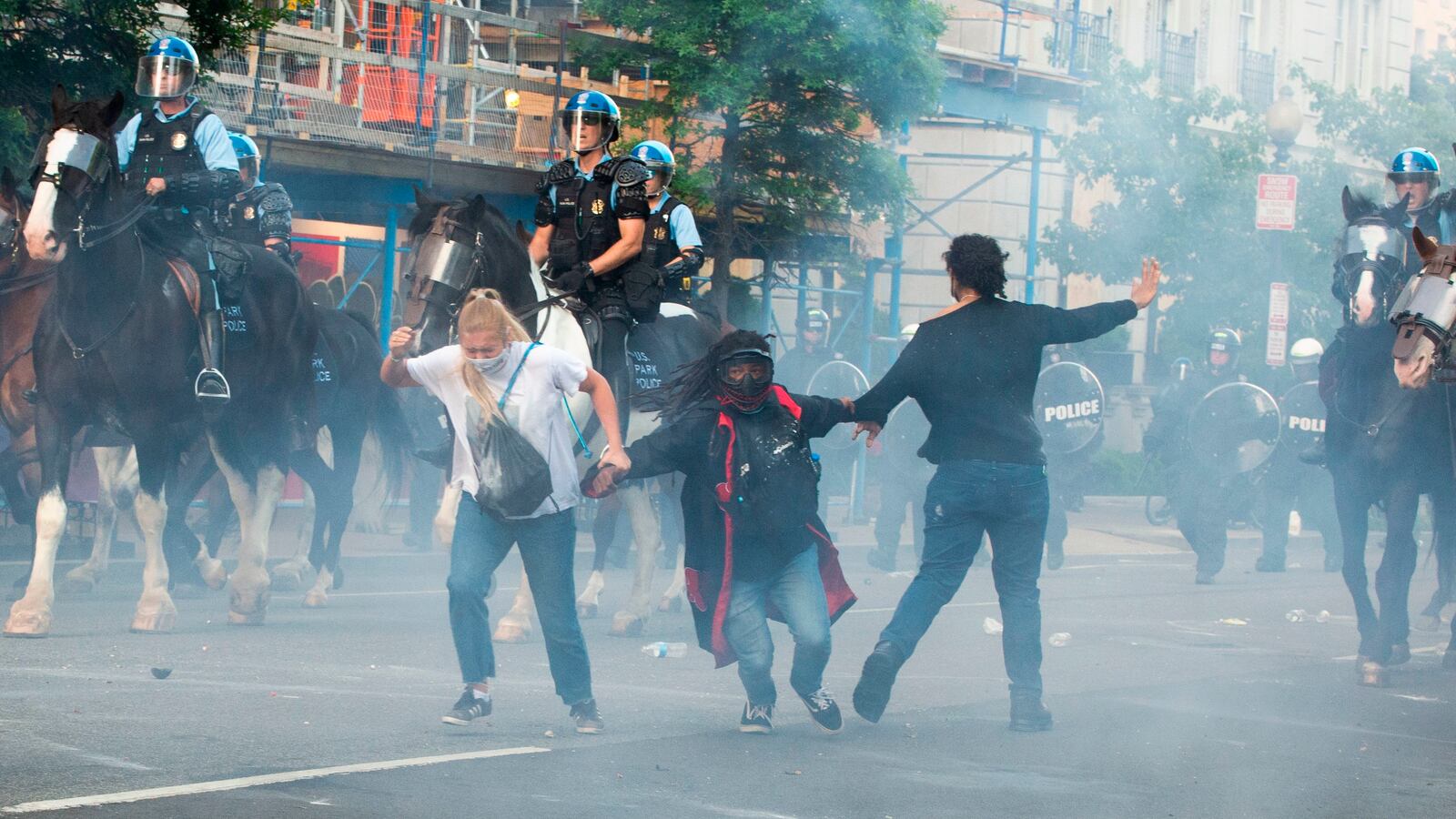Moments before President Trump was scheduled to take the podium to address nationwide protests against police brutality in the wake of George Floyd’s death, police officers near the North Lawn of the White House charged at peaceful protesters, throwing tear gas as they aggressively attempted to disperse the crowd.
Dozens of people in the crowd were yelling, some with both hands above their heads, as police continued to infiltrate the scene, pushing them back with shields emblazoned “MILITARY POLICE.”
At various junctures, the startling sound of flash-bangs broke out, ringing though the air even as Trump began to speak, declaring himself the “president of law and order.”
After nightfall, the heavy-handed tactics continued, with Army helicopters buzzing low over protesters still milling about on the streets.
The protesters had been gathered peacefully outside the White House, until cops in riot gear moved in on them, engaging in a tense standoff that lasted for minutes. They then charged at the crowd, swinging batons and firing tear gas moments before Trump delivered remarks at the Rose Garden.
“All of a sudden they started forming lines and next thing you know next we started hearing was booms,” protester Willie Smith told The Daily Beast. “TV does it no justice… It’s really bogus—I’m disappointed with way things are going.”
The tear gas was apparently used to break up protesters near St. John’s Episcopal Church—which had been partially lit on fire Sunday night—so that Trump could take a photo in front of it after his speech. Trump, standing for several minutes with White House Press Secretary Kayleigh McEnany, Attorney General Bill Barr, and others, held up a Bible in front of the church as cameras flashed.
Mariann Budde, bishop of the Episcopal Diocese of Washington, would later denounce Trump for clearing protesters with force “so they could use one of our churches as a prop.”
“We need moral leadership, and he’s done everything to divide us,” she told The Washington Post, adding that she and the church’s rector were not informed of Trump’s intentions ahead of time.
About a half-hour after Trump left the church, the large police presence continued to block off various streets, boxing in and dividing up chunks of protesters and activists on different blocks, systematically trying to push them back further and further from the White House.

In his nearly six-minute speech—against a backdrop of flash-bangs and tear gas—Trump said he was “dispatching thousands and thousands of heavily armed soldiers, military personnel, and law enforcement officers to stop the rioting, looting, vandalism, assaults, and the wanton destruction of property.” He called the unrest “acts of domestic terror.”
“Those who threaten innocent life and property will be arrested, detained, and prosecuted, to the fullest extent of the law,” he said. “I want the organizers of this terror to be on notice that you will face severe criminal penalties and lengthy sentences in jail. This includes Antifa and others leading instigators of this. One law and order and that is what it is, one law, we have one beautiful law.”
While it was initially unclear, a senior Defense Department official told The Daily Beast that Trump had not invoked the 19th century Insurrection Act, which empowers the president, in cases of “unlawful obstructions, combinations, or assemblages, or rebellion against the authority of the United States” to use the military “to suppress the rebellion.” But he said if the governors “refuse to take action” for that suppression “then I will deploy the United States military and quickly solve the problem for them.”
“I refer you to the White House for more,” the official said.
Eugene R. Fidell, a senior research scholar at Yale Law School and one of the nation’s premiere experts in military law, said Trump has “already crossed the rubicon.” He added that Trump cannot suspend the writ of habeas corpus, but the nation might see “a further challenge” to the federal courts’ role as guarantors of the constitutional order.
“The president has declared war on the federal system,” Fidell said. “In a host of ways, he has labored to emasculate the states as separate sovereigns. This evening’s developments have to be understood in this broader cont. I believe the circumstances we’re now seeing augur in a chapter where the most settled parts of the American national government—the relationship between the federal union and sovereign states—are under assault.”
“The Framers,” Fidell continued, “would be appalled if they were somehow made aware of this.”

The photo op that protesters got tear-gassed to make happen.
Brendan Smialowski/ AFP via GettyDuring his speech, Trump said he’s strongly recommended to every governor to deploy the National Guard “in sufficient numbers.”
“Mayors and governors must establish an of willing law-enforcement presence until the violence has been quelled,” he said. “If a city or state refuses to take the actions necessary to defend the life and property of the residents, I will deploy the United States military, and quickly solve the problem for them.”
Afterward, Illinois Gov. Pritzker told CNN that Trump cannot send troops into Illinois. “The president has created an incendiary moment... He should be calling for calm. He should be bringing the temperature down. He’s doing the opposite,” he said, adding, “He should stay out of our business.”
Sen. Ron Wyden (D-OR) slammed Trump’s “fascist speech,” saying it “verged on a declaration of war against American citizens,” while Rep. Adam Smith (D-WA) deemed it “un-American to use our service members to ‘dominate’ civilians, as both the President and Secretary of Defense have suggested.”
“We live in a democracy, not a dictatorship,” he added.
The president’s remarks come just hours after he convened a call with the nation’s governors on Monday, where he said they have to “dominate” or would end up looking like “a bunch of jerks.”
“You have to dominate. If you don’t dominate... you’re wasting your time,” he said on a private conference call, according to audio obtained by The Daily Beast. “They’re going to run over you, you’re going to look like a bunch of jerks.”

In his address to the country Monday evening, he turned his attention towards Washington, D.C., less than 24 hours after peaceful demonstrations boiled over into a chaotic night of fires, destruction, and vandalism—all within sight of the windows of the White House residence.
Shortly before an 11 p.m. curfew Sunday night, protesters set fire to a small building in Lafayette Park, which abuts the White House grounds, and started a fire at St. John’s, a historic church across the street where presidents have worshipped through history.
Sunday night was the most violent to date of demonstrations in the nation’s capital. Before and after police began dispersing crowds with tear gas and flash-bang grenades, the tenor of the protests was unmistakably influenced by the man sitting on the other side of a layer of protection he’d bragged about on Twitter days before.
People chanted “fuck Trump!” and emblazoned that message through graffiti on seemingly every surface, from street signs and sidewalks to boarded-up office buildings and the sign marking the headquarters of the AFL-CIO, two blocks from the White House.




